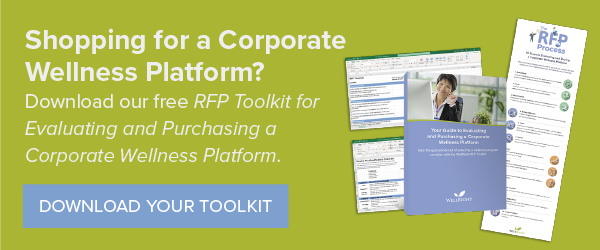
“How much should our corporate wellness program cost?”
It seems like a simple question, but it’s not easy to get a straight answer. There’s plenty of conflicting information out there, and not a lot of transparency about what goes into the costs involved.
But that’s OK, because we’ve got answers for you that will help you plan out a corporate wellness program budget that’s attainable and effective.
To cost out a corporate wellness program that fits your budget and your goals, make sure you follow three important best practices.
3 Best Practices When Planning Corporate Wellness Program Costs
1. Be realistic about your average spend per employee.
2. Save (so you can spend) on services employees want and need.
3. Consider other budget items that impact program success.
Let’s start with the average cost for each employee, as it’s top-of-mind for anybody planning a wellness program.
1. Be Realistic About Your Average Spend Per Employee
Realistically, in dollars and cents, the average budget a company should expect to allocate for their wellness program with the hope of any monetary return is in the $100-$150 per participant range—excluding the cost of incentives.
If that number surprised you, you’re not alone. We often talk to employers that start with a budget of $25 to $50 per employee per year. A budget like that may seem reasonable … until they discover that an annual biometric screening alone costs $30 or $40 per participant.
Unfortunately, a restrictively low budget results in a corporate wellness program that doesn’t do much of anything.
For example, let’s say several employees find out in their screening that they have high blood pressure, high cholesterol or pre-diabetes. If that screening blows your entire budget, how can you develop any programming to help them improve their health (and your health care costs)?
Related Reading: The Cost of an Employee Wellness Program
Your Wellness Program Is an Investment in Preventive Care
The claims associated with treating conditions like diabetes, heart disease, and cancer are exponentially higher than those associated with the exams and screenings that prevent them. Your corporate wellness program can be proof that in the long run, being proactive and preventive is less expensive than reacting to illness and disease.
Initially, companies with self-funded insurance will see an uptick in claims for flu shots, annual physicals, mammograms, prostate exams and other preventive care. This increase in costs might spook your CFO, but they need to be patient: They’ll soon see that focusing on (and incentivizing) preventive care can lead to normally very expensive conditions being caught and treated earlier … and much more economically.
2. Save (So You can Spend) on Services Employees Want and Need
Whether your budget is lavish or bare-bones, consider how you can optimize it and stretch your dollar even further. A savvy move is to see what you can provide inexpensively, so you can save your budget for important extras.
For example, hospitals and health care organizations can take advantage of their in-house expertise: The cost of providing nutritional services and even disease-specific programs can be absorbed internally. Even preventive care can be provided internally at minimal cost.
Of course, not all companies have health professionals on hand. Still, they can leverage what’s available through their insurance carrier. Look to see if your carrier offers chronic condition management for diabetes, heart disease and other common conditions. If your EAP provider has informational sessions, webinars, podcasts, blogs or other media, make sure they’re widely promoted to employees.
The idea is to utilize anything and everything you can that doesn’t add to your budget—leaving you more to spend on other specialized services.
Leave Room in Your Budget for Specialized Services
By driving a few smart bargains when developing your wellness program budget, you can stretch your dollars to cover specialized (but deeply necessary) services.
Which services are these? That depends entirely on your people: Your employees’ biometric screenings and annual physician visits can provide information to help you determine which types of disease management services you may want to offer as part of your wellness program.
Identifying the top areas of the organization's healthcare spend with your carrier or Benefits Consultant can provide critical insights as to where your wellness program should be focused and where your budget will make the biggest difference.
In addition to disease management, it’s crucial in today’s workplace to offer support for employees’ mental and emotional well-being. Strongly consider allocating extra budget toward a mental health component that provides convenience and discretion for your employees. An economical but helpful option is to explore digital mental health solutions that allow employees to message counselors at their convenience while also using self-guided services to develop healthy habits.
3. Consider Other Budget Items That Impact Program Success
The next step is to make sure your program isn’t a non-starter. If you’ve read our Best Practices for Workplace Wellness Program Success guide, you’ll know that successful wellness programs share several commonalities, such as:
- A wellness champion network
- A wellness platform
- A marketing plan
- A dedicated “owner”
- A flexible approach
Including each of these items in your corporate wellness program budget will greatly improve program adoption and long-term adherence—after all, even the best program won’t lower your health care costs if nobody hears about it, tries it or sticks with it.
A Wellness Champion Network
Your wellness champion network should be packed with company leaders, diversity advocates, and employee representatives to identify overarching goals and to make sure your wellness program is always working toward accomplishing those goals.
Related Reading: Guide to Building Your Wellness Champion Network
A Corporate Wellness Platform
Your wellness platform is like the “brains” of your corporate wellness program. All data points lead to your platform—biometric screenings, wellness challenges and tracking, incentive and reward accruals and communications can all be orchestrated with a comprehensive wellness platform. Your wellness platform can also give you access to data in the form of engagement statistics, progress reports, aggregate reporting, and more!
When designing or choosing a wellness platform, keep in mind that privacy will be a concern among employees (and legislators), making it vital to prioritize a platform that employees will feel safe and comfortable using.
A Marketing Plan
That’s where your wellness program marketing plan comes in. Your employees need to know everything about the wellness program: How it works, the challenges, the incentives, and how their information is used. To get them on board, your marketing outreach needs to create excitement while being clear and informative. Remember to budget for ongoing outreach: You’ll need to rekindle excitement every time the program shows signs of waning.
A Dedicated “Owner”
So, how does this all come together? You’ll need a dedicated resource—or at least half of one. Having a wellness champion network is critical, but day-to-day management by committee is a recipe for disaster. You’ll need to designate someone who is responsible for overseeing your wellness program and raising the red flag if something is going awry.
Too often, companies tap an already overcommitted staff member for this role. Don’t do that. You’re setting your program up for failure before you even start. The best practice we recommend to all our clients is to allocate a resource who can dedicate at least 50% of their time.
A Flexible Approach
Our last suggestion to help you lay the groundwork for success is to make sure your program can roll with the punches.
Not every wellness challenge and service is going to work for every employee. Some may thrive on competitive weigh-ins and running challenges. Others will hate that with the heat of a thousand suns, preferring to focus on gentler forms of wellness.
You’re working with people—they’re human and they crave empathy and belonging. Be flexible with your challenges, your rewards and your incentives, so you set your employees up for success too.
Make Your Corporate Wellness Program Costs Work for You
As stated earlier, when creating a budget for your corporate wellness program, expect to pay between $100 and $150 per member, plus the cost of incentives you choose to provide to employees.
When you consider that a well-executed wellness program has the potential to realize a ROI of between $1.50 and $3.00 per dollar spent, it becomes easy to see why it’s so important to look at your wellness program as an investment in your people—and in the future health of your business.




